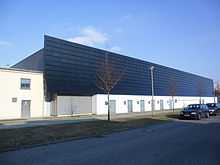Ferdinand-Braun-Institut

The Ferdinand-Braun-Institut, Leibniz-Institut für Höchstfrequenztechnik (FBH) is a research institute, which belongs to the Forschungsverbund Berlin e. V. (FVB) and is a member of the Gottfried Wilhelm Leibniz Scientific Community. The institute is located in Berlin at the Wissenschafts- und Wirtschaftsstandort Adlershof (WISTA), its research activity is applied science in the fields of microwaves und optoelectronics.
History
The institute arose from the former „Zentralinstitut für Optik und Spektroskopie“ der Akademie der Wissenschaften der DDR. Based on a recommendation of the Wissenschaftsrat, it was reestablished on January 1, 1992.
The institute is named after Ferdinand Braun (1850–1918), who received the Nobel Prize for physics in 1909 for his contributions on the development of wireless telegraphy.
Business areas and research
The Ferdinand-Braun-Institute explores technologies in the fields of microwaves and optoelectronics. The activities are based on III-V semiconductor technology and are focused on applications in information- and communications technology, in sensors as well as in laser technology. Emphasis is given in microwave technology to the design and fabrication of transistors and integrated microwave circuits, in optoelectronics to high-power laser diodes, high brilliance lasers and hybrid-integrated laser systems.
The FBH is organized in the following business areas:
- Microwave Components and Systems
- - Front ends up to 100 GHz
- - Power amplifiers up to 10 GHz
- - Low-noise components
- - Microwave plasmas
- - Terahertz electronics
- GaN Electronics
- - Microwave transistors & MMICs
- - Power electronics
- Diode Lasers
- - Broad area lasers and bars (spectral range 0.6 - 1.2 µm)
- - High-brightness lasers (line width < 10 MHz)
- - Hybrid laser systems
- - Laser sensors
- - Laser metrology
- GaN Optoelectronics
- - UV high power laser diodes
- - Blue & green laser diodes
- - UV-LEDs
- Materials and Process Technology
- - GaN-HVPE
- - Special optical devices
- - In-situ control techniques for MOVPE & HVPE
- - Laser micro processing
Services from the FBH comprise e.g. prototyping of electronical and optoelectronical GaAs devices, epitaxy of GaAs-based layer systems, the development of GaAs processes, pilot series of integrated microwave circuits and laser diodes, consulting in rf measurement technology and the simulation of coplanar waveguide circuits.
The institute operates an industry-compatible clean room facility including MOVPE on wafers from 2" to 6" and a process line for wafers from 2" to 4". It operates materials and process analytics, device measurement facilities and tools for simulation and CAD.
Cooperations
The institute cooperates with national and international universities, research institutions and industrial companies. The FBH offers services from epitaxy and process steps up to complete devices and systems.
The Ferdinand-Braun-Institut belongs to the "Forschungsverbund Berlin e.V." and is a member of the "Leibniz Association(Wissenschaftsgemeinschaft Gottfried Wilhelm Leibniz e.V., WGL)". Furthermore, the FBH is a member of the "Zentrum für Mikrosystemtechnik (ZEMI)", a network of research institutes on microsystem technologies located in Berlin. The FBH is also member of OpTecBB, an initiative of research institutes and companies for the development and use of optical technologies.
In the academic field, there is a close cooperation with the TU Berlin and other universities in Berlin and in Germany.
Spin-offs
Spin-offs from research institutes are part of a strategy to transform scientific results into innovative and profitable products. At FBH, several successful spin offs have be initialized. Here some examples:
In 1999, employees of the FBH founded a company to produce semiconductor layer systems which acts as basis for devices like laser diodes, LEDs, transistors (HBTs) or Schottky-Diodes.
A company founded in 2002 develops in close cooperation with the FBH high-power laser diodes with wavelengths from 650 nm to 1120 nm which are used in medical, scientific and industrial applications.
In 2006, a company was founded which develops, produces and sells high-power Galliumnitride transistors (GaN) for future applications in mobile communications.
Infrastructure
The director of the FBH, Prof. Dr. Günther Tränkle, is a Professor at the Technischen Universität Berlin and holding the chair for microwave and optoelectronics. Tränkle manages the FBH since 1996.
The institute has about 240 employees, including 95 scientists and 35 students.
The total turnover in 2007 was 17,1 million Euro including 5,9 million Euro governmental funding and 2,2 million Euro from industrial contracts.
| Wikimedia Commons has media related to Ferdinand-Braun-Institut. |
External links
- Homepage of the Ferdinand-Braun-Institut, Leibniz-Institut für Höchstfrequenztechnik
- Homepage of the Forschungsverbund Berlin e.V.
Coordinates: 52°25′43″N 13°32′02″E / 52.42861°N 13.53389°E